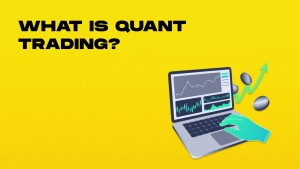What Is Quantitative Trading?
Quant trading (or algorithmic trading) uses mathematical models and computer algorithms to execute trades with little to no human intervention. Unlike discretionary trading where humans make decisions based on analysis and intuition, quant trading relies on automated trading systems to execute trades with precision and consistency.
The core principle is simple: identify market patterns using statistical analysis, then let algorithms execute trades based on those patterns.
A strong foundation in computer programming is essential for developing and implementing these systems.
How Quant Trading Works
Quant trading operates through a systematic process:
-
Strategy development: Identifying market patterns and creating mathematical models
-
Backtesting: Testing strategies against historical data
-
Implementation: Coding the strategy into trading algorithms and sophisticated trading systems
-
Execution: Automated trading with minimal human intervention
-
Monitoring and optimization: Continuous improvement of the strategy
These strategies often focus on market inefficiencies—moments when assets are slightly mispriced or trends that can be exploited before the broader market catches on.
Data science principles are crucial for analyzing market data and developing effective trading strategies.
The Role of a Quant Trader
A quant trader, also known as a quantitative trader, is a finance professional who uses mathematical models to evaluate trade possibilities and forecast financial market behavior. These traders work closely with quantitative researchers to develop and implement sophisticated trading strategies. Their responsibilities extend beyond just executing trades; they also manage risk and make informed decisions based on quantitative analysis.
To excel as a quant trader, one needs a robust foundation in programming languages, such as Python, and a deep understanding of financial markets. Quant traders typically find employment in investment banks, hedge funds, and other financial institutions. They are expected to stay abreast of the latest market trends and technological advancements to maintain a competitive edge.
Quant traders leverage their expertise in mathematical models to identify trading opportunities and optimize trade selection. Their role is crucial in ensuring that trades are executed efficiently and that risks are managed effectively. By combining their knowledge of trading strategies with advanced quantitative analysis, quant traders play a pivotal role in the financial markets.
Why Quant Trading Matters
Quant trading isn’t just for Wall Street firms anymore. Here’s why it’s becoming increasingly important for individual traders:
The growing demand for quant traders has led to numerous employment opportunities in global financial hubs like London and Hong Kong. This demand highlights the positive job outlook for quantitative traders and financial analysts in key markets.
A strong understanding of quantitative finance is essential for success in this field.
The Advantages Over Traditional Trading
-
Emotion removal: Algorithms don’t fear market crashes or get greedy during rallies
-
Speed and efficiency: Computers can analyze thousands of securities in milliseconds, allowing for rapid analysis and execution of trades in high frequency trading
-
Consistency: Strategies are applied precisely without deviation
-
Backtesting capability: You can test strategies on decades of historical data before risking real money
-
Diversification: Ability to trade multiple strategies and markets simultaneously
-
Risk management: Effective risk management practices are crucial for protecting investments and ensuring long-term success
As markets become more complex and competitive, the advantages of algorithmic precision become increasingly valuable.
Common Quant Trading Strategies
Quant traders analyze trading volume to identify market trends and opportunities, employing various strategies, each with different approaches to finding market edges.
Quant trading strategies attract a diverse set of traders with various backgrounds and expertise.
Trend Following
This strategy assumes that assets moving in a particular direction will continue that trend. Financial analysts play a crucial role in identifying and capitalizing on market trends. Algorithms identify and capitalize on momentum by:
-
Tracking moving averages
-
Measuring price momentum
-
Analyzing breakouts from established ranges
Mean Reversion
Quantitative traders use mean reversion strategies to identify and exploit price deviations. Based on the principle that prices eventually return to their historical average, these strategies:
-
Identify overbought or oversold conditions
-
Calculate statistical deviations from average prices
-
Buy low and sell high within established ranges
Statistical Arbitrage
This approach, often employed by investment firms, exploits price differences between related securities by:
-
Identifying pairs of correlated assets
-
Detecting when their price relationship deviates
-
Simultaneously buying the undervalued asset and selling the overvalued one
Market Making
Market making is a trading strategy that involves providing liquidity by placing both buy and sell orders. Market makers provide liquidity by:
-
Placing both buy and sell orders
-
Capturing small price spreads
-
Managing inventory to minimize risk
Algorithmic Trading
Algorithmic trading is a type of trading that uses computer programs to execute trades based on predefined rules and models. This approach leverages quantitative analysis, machine learning, and other advanced techniques to analyze market data and make trading decisions. Widely used in financial markets, algorithmic trading has become an essential tool for many traders and investors.
Quant traders utilize algorithmic trading to optimize trade selection, execute trades, and manage risk. By analyzing large datasets, they can identify patterns and make predictions about future market movements. This allows them to make faster and more accurate decisions, automating many of their trading tasks.
The use of algorithmic trading enables quant traders to process vast amounts of market data in real-time, providing them with a significant advantage over traditional trading methods. By employing sophisticated computer programs and machine learning algorithms, they can execute trades with precision and efficiency, ensuring that they capitalize on market opportunities as they arise.
In summary, algorithmic trading empowers quant traders to enhance their trading strategies, improve decision-making, and achieve better trading outcomes. It is a critical component of modern quantitative trading, driving innovation and efficiency in the financial markets.
Getting Started With Quant Trading
You don’t need a PhD to start quant trading, but having a bachelor's degree in a relevant field can be beneficial. Here’s a practical path to begin:
To become a quant, you should consider obtaining advanced degrees in quantitative subjects, such as a master's or Ph.D., and developing essential software skills for algorithmic trading. Specialized courses in Python coding and financial analysis can also enhance your job readiness in the field.
Essential Skills to Develop
Focus on building these core competencies:
-
Programming: Learn Python (the industry standard for quant trading)
-
Computer science: A strong foundation in computer science is essential for developing and implementing trading algorithms. Professionals with backgrounds in computer science are equipped to handle complex data analysis and automated trading systems.
-
Statistics and probability: Understand basic concepts like mean, standard deviation, and correlation
-
Financial markets knowledge: Familiarize yourself with different asset classes and market mechanics
-
Data analysis: Develop skills to clean, manipulate, and visualize financial data
Tools and Resources for Beginners in Automated Trading Systems
| Resource Type | Recommendations |
|---|---|
| Trading Platforms | QuantConnect, Alpaca, Interactive Brokers |
| Programming Libraries | pandas, NumPy, scikit-learn, Matplotlib |
| Educational Resources | Quantopian Lectures, "Python for Finance" by Yves Hilpisch, Ernest Chan's books |
| Data Sources | Yahoo Finance, Alpha Vantage, Quandl |
Quant trading internships and experiences are not limited to India and the US; there are significant opportunities available in other countries as well. This global reach allows beginners to access a wide range of tools and resources to kickstart their journey in quantitative trading.
Building Your First Strategy
Start simple with these steps:
-
Select a single, liquid market (like S&P 500 ETFs)
-
Choose a basic strategy (like a moving average crossover)
-
Collect historical price data
-
Implement the strategy in Python
-
Backtest with realistic assumptions (including transaction costs)
-
Start with paper trading before using real money
In addition to these steps, acquiring other qualifications can enhance a trader's skills and competitiveness in the market.
Common Challenges and How to Overcome Them
Quant trading isn’t without obstacles. Overcoming these challenges can lead to a fantastic job in quant trading. Here’s how to navigate the common pitfalls:
Overfitting and Data Mining Bias
When your strategy works perfectly on historical data but fails in live trading, you’ve likely overfitted your model. A strong understanding of quantitative finance can help traders avoid overfitting and data mining bias. To prevent this:
-
Use out-of-sample testing
-
Keep strategies conceptually simple
-
Be skeptical of strategies with too many parameters
-
Apply walk-forward analysis
Technology and Infrastructure
Technical issues can derail even the best strategy:
-
Reliable automated trading systems are crucial for successful quant trading, so start with cloud-based platforms to avoid infrastructure headaches
-
Implement thorough error handling in your code
-
Create alerts for system failures
-
Have backup execution methods ready
Market Changes and Adaptation
Markets evolve, and quantitative traders must continuously adapt their strategies to stay competitive, invalidating previously profitable strategies:
-
Regularly review and reoptimize your strategies
-
Diversify across multiple uncorrelated approaches
-
Monitor strategy performance metrics daily
-
Prepare to pause trading during abnormal market conditions
The Future of Quant Trading
The quant trading landscape continues to evolve rapidly. Here's what to watch:
Emerging Trends
-
Machine learning integration: Increasingly sophisticated AI models are finding patterns humans can’t detect
-
Alternative data sources: From satellite imagery to social media sentiment, non-traditional data is creating new edges
-
Blockchain applications: DeFi platforms are opening new algorithmic trading opportunities
-
Democratization: Obtaining a master's degree can help traders stay ahead of emerging trends in quant trading. Better tools are making quant trading accessible to smaller players
Conclusion
Quant trading offers a disciplined, systematic approach to markets that removes emotional biases and captures opportunities with precision. While it requires effort to learn, the barriers to entry are lower than ever.
Start small, focus on learning the fundamentals, and gradually build your skills. Even implementing basic quantitative principles can improve your trading results dramatically.
Remember: the goal isn’t to create the most complex system, but to develop a reliable, consistent approach that works for your resources and risk tolerance.
Ready to become a quant trader? The tools and knowledge are more accessible than ever—all that’s missing is you.
























